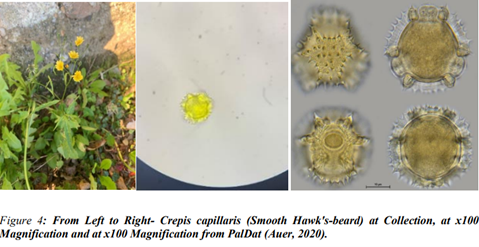Paper Authors and Title
Kathlyn Feeney (Atlantic Technological University), Paul Hamilton, “The Effect of Anthropogenic Activities on the Pollination of Wildflowers”
Abstract
Many human activities have the potential to impact on the pollination of wildflowers. For this study the effect that anthropogenic air pollutants have on wildflower pollen quality was examined. As previous studies show, air pollutants can restrict the pollination process by altering pollen grains and decreasing viability and germination. Successful pollination is important as many plants rely on pollination for sexual reproduction, which allows species to survive and spread through the environment. Pollen is also a food source for many insect species, especially bees, who use it as their main source of energy. Without pollination many vital ecosystem services would be lost, from both wildflowers and their pollinators.
To examine the pollen of wildflowers samples were collected from 3 locations in Co. Sligo and air quality data was obtained from the EPA website. Pollen was extracted from the wildflower samples and treated with glycerine before being viewed under a light microscope at x1000 magnification. Samples were then assessed in comparison with samples found on palynological database PalDat and compared based on their size, shape and overall structure. Air quality data for Sligo was then evaluated to determine if any exceedances of air quality limits occurred at the time of sampling and if this may have influenced pollen quality. The pollutants which were measured in Sligo’s monitoring station were PM10, PM2.5 and NO2. The data showed that although no EU limits were exceeded for the pollutants measured, WHO daily guidelines were exceeded for all pollutants on multiple occasions.
References
Azzazy, M. (2016) “Environmental impacts of industrial pollution on pollen morphology of eucalyptus globulus labill. (Myrtaceae),” Journal of Applied Biology & Biotechnology, 4(5), pp. 052–062. Available at: https://doi.org/10.7324/jabb.2016.40509.
Cuinica, L.G., Abreu, I. and Esteves da Silva, J. (2014) “Effect of air pollutant NO2 on Betula pendula, Ostrya carpinifolia and Carpinus betulus pollen fertility and human allergenicity,” Environmental Pollution, 186, pp. 50–55. Available at: https://doi.org/10.1016/j.envpol.2013.12.001.
Majd, A. et al. (2004) “The effects of air pollution on structures, proteins and allergenicity of pollen grains,” Aerobiologia, 20(2), pp. 111–118. Available at: https://doi.org/10.1023/b:aero.0000032950.12169.38
Rezanejad, Farkhondeh (2007) “The Effect of Air Pollution on Microsporogenesis, Pollen Development and Soluble Pollen Proteins in Spartium junceum L. (Fabaceae),” Turkish Journal of Botany: Vol. 31: No. 3, Article 2. Available at: https://journals.tubitak.gov.tr/botany/vol31/iss3/2
Sénéchal, H. et al. (2015) “A review of the effects of major atmospheric pollutants on pollen grains, pollen content, and Allergenicity,” The Scientific World Journal, 2015, pp. 1–29. Available at: https://doi.org/10.1155/2015/940243.

